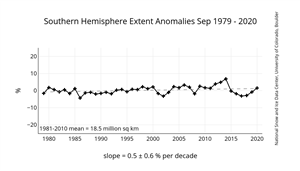Harry Macdonald:
So Jon, Steward, you are saying that it wasn't over 30°C for a week in the Arctic circle this year and that the Artic ocean has had decreasing ice cover every year.
The problem is that the excess heat going into the atmosphere is resulting largely in warmer seas and melting ice. The actual temperature rise is very modest - for the moment.
It was over 30°C in the Artic circle this year as it has often been in the past. Nothing unusual, the area has permenant sun in summer time. (It also often under -30°C in winter)
https://climexp.knmi.nl/gdcntmax.cgi?id=someone@somewhere&WMO=RSM00022383&STATION=NIZHNYAYA_PESHA&extraargs=
Why is there a need to 'hype' normal weather? Is it beacause there is no real evidence for AGW. There is plenty of evidence that the Earth is naturally warming since the last Ice Age. Arctic ice cover is also slowly decreasing for the same reason. It is interesting that Antarctic ice is stable to increasing.
https://nsidc.org/data/seaice_index/
I am not talking about that kind of management.
There is no point whatever in running an electric car unless it is solely charged from "renewables"
All of this assumes that EV drivers would be happy that they had no control of the charge in their car
Detecting that a CNE connection has failed is very difficult because there is no reference potential available, and using a TT type connection as reference has many problems which we have discussed many times. IF the supply is 3 phase, we may use the 3 phase/neutral voltages to recognise a break under some fairly ideal conditions, but load power factors and powers may seriously sway the results so as to make them unreliable. With a single phase supply there is no isolated Earth reference available, and thus it is probably impossible to detect a CNE break. If someone comes up with a non-TT method I would be interested to analyse it fully and the Patent application would be unlikely to succeed if it could not be shown to work under any possible conditions, by demonstration.
Roger Bryant:
Chris,
The problem is global warming is not the real issue. We should be looking at conserving the planets finite resources and reducing harmful pollution (which does not include the plant food CO2).
The current 'Green' plans are incredibly resource hungry and highly polluting due to the production of the raw materials. Unfortunately wind turbines and solar panels are not made from unicorn poo.
I couldn't agree more. It's all very well manufacturing highly efficient new cars, or highly insulated new houses, but throwing them away when they have years of life left in them seems to be madness.
Plastic pollution is my biggest bugbear. Why oh why do half a dozen rashers of bacon, or sausages, or a couple of chops, or WHY have to come in a plastic tray with a non-recyclable cover?
We're about to take you to the IET registration website. Don't worry though, you'll be sent straight back to the community after completing the registration.
Continue to the IET registration site